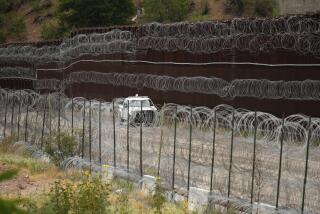U.S. Refugee Policy Still Keeps Out 99% of the Oppressed
WASHINGTON â A steadily lengthening line of Soviet Jews and Armenians trying to get into the United States has focused attention on a U.S. refugee policy that, despite more than a century of open-door rhetoric, is designed to keep out at least 99 of every 100 of the worldâs persecuted and oppressed.
At any one time, there are between 10 million and 13 million refugees in the world--people who have fled their own countries because of political, religious or ethnic persecution and who fear imprisonment or death if they are forced to return. Of those refugees, only about 100,000 a year have much chance of reaching the United States or any other Western country.
âOnly 1% of the people we feel are refugees and in need of help will ever be resettled,â a State Department official said. âBeing a refugee does not automatically get you into a queue to come to the United States.â
Almost Automatic Admission
Until a sudden outpouring of Soviet citizens overwhelmed the system late last year, being a refugee from Soviet communism did, in practice, allow virtually automatic admission to the United States. And Soviet refugees still have a far higher chance of coming to this country than do refugees from Central America, the Caribbean and parts of Africa.
U.S. officials acknowledge that politics plays a major role in deciding who is a refugee. For example, in addition to the special status accorded Soviet citizens, people fleeing the Marxist regimes in Vietnam, Poland, Afghanistan and Ethiopia also have a very good chance of reaching the United States and remaining here.
Individuals from those countries who do not qualify as refugees are normally allowed to stay under a program known as âextended voluntary departure,â which in effect means they can remain until U.S. officials determine that conditions in their homelands have improved--a process that could take many years.
However, because El Salvador has a pro-Western elected government, its citizens are normally refused even âextended voluntary departureâ status despite a festering civil war in which civilians are frequently the targets of both army and rebels.
Definition of Refugees
Under international law and U.S. statutes, refugees are defined as persons who have fled their countries because of well-founded fears of immediate persecution that stem from their politics, religion, race or ethnic group.
The oppressor, however, must be the government. Those who flee because of crime, random violence or endemic poverty and starvation do not qualify.
By this definition, Haitians are normally denied refugee status despite the island republicâs long tradition of violent and oppressive government, because they are thought to be trying to escape poverty.
Salvadorans and most other Central Americans are regularly rejected because the danger of death that they face is not considered to be the exclusive fault of the government. Nicaraguans, who once enjoyed the special status of escapees from communism, have had more trouble recently because they often are classed as economic refugees.
âLegalisticâ Distinction
One U.S. official conceded that the sort of danger that produces refugee status is no worse than the kind that does not. The distinction is a âlegalisticâ one, he said, but the government has no choice but to apply the law.
Everyone who seeks to enter the country as a refugee is interviewed by the federal Immigration and Naturalization Service. It is often a haphazard process.
A U.S. official acknowledged that it is usually impossible to check a personâs claim of fear of persecution. âThe more likely one is to have been persecuted,â the official said, âthe less likely it is that they have documents showing that.â
The decision whether to grant asylum, the official said, depends on âwhether we believe what the applicant is telling us rings true with what else we knowâ about the country.
For years, the United States hectored the Soviet Union to let more people go. Now, President Mikhail S. Gorbachev has permitted such a substantial increase in emigration--most of it among Jews and Armenians--that the U.S. network for handling refugees has been swamped.
âWeâre a victim of our own success,â said Delia B. Combs, an assistant INS commissioner. âNow, we are getting people who we have asked for for many, many years, and we donât have the moneyâ to process and support them as refugees.
It could be argued that because of Gorbachevâs reforms, Soviet Jews no longer face the sort of persecution that qualified them for refugee status before Gorbachev took over. But the U.S. government has rejected applying such a Catch-22 to Soviet Jews.
Before he left office last month, former Secretary of State George P. Shultz promised that all Soviet emigres who want to live in the United States would be permitted to do so.
âPart of the reason I think that the government is so generous right now is that we donât want to miss an opportunity to get as many people here as we can--just in case the politics of that country, or indeed any other country, might change,â Combs said.
Jewish groups, protesting the special parole status, argue that every Soviet Jew should be granted refugee status, which entitles them to more public aid and makes it easier for them to apply for U.S. citizenship.
Thousands of Central Americans, held in a detention center in south Texas, would jump at parole or extended voluntary departure status. Under a new INS policy, they face quick deportation if they fail--as most of them do--to qualify for refugee status. As many as 100,000 Central Americans are expected to be denied entry this year.
Only 2,497 Latin Americans were admitted to the United States as refugees during the fiscal year that ended Sept. 30. That compared with 35,015 from Asia, mostly Vietnam; 20,421 from the Soviet Union, and 7,818 from other countries of Eastern Europe.
The discrepancy may be even greater this year. In the first three months of the current fiscal year--October, November and December, 1988--only 225 refugees from Central America were admitted, compared with 6,028 from the Soviet Union and 1,826 from Eastern Europe.
Since the Soviets began allowing large numbers of people to leave the country, INS officials, operating out of the U.S. Embassy in Moscow, have worked feverishly to keep up with the crush of refugee applicants. INS officials said that 4,200 new applicants registered in Moscow in January and that, by the end of the month, 16,616 applicants had not been interviewed.
U.S. officials say that most of the potential refugees applying at the embassy in Moscow are Armenians. Most Jews, they say, leave the Soviet Union with visas to enter Israel, but once they reach Europe, about 90% of them seek admission to the United States instead.
In Moscow, U.S. officials are passing out pink forms telling potential immigrants that âgiven the large number of applications, we . . . must inform you that there could be delays of up to a year or more before your application can be reviewed.â
More to Read
Sign up for Essential California
The most important California stories and recommendations in your inbox every morning.
You may occasionally receive promotional content from the Los Angeles Times.




![[20060326 (LA/A20) -- STATING THE CASE: Marchers organized by unions, religious organizations and immigrants rights groups carry signs and chant in downtown L.A. "People are really upset that all the work they do, everything that they give to this nation, is ignored," said Angelica Salas of the Coalition of Humane Immigrant Rights. -- PHOTOGRAPHER: Photographs by Gina Ferazzi The Los Angeles Times] *** [Ferazzi, Gina -- - 109170.ME.0325.rights.12.GMF- Gina Ferazzi/Los Angeles Times - Thousands of protesters march to city hall in downtown Los Angeles Saturday, March 25, 2006. They are protesting against House-passed HR 4437, an anti-immigration bill that opponents say will criminalize millions of immigrant families and anyone who comes into contact with them.]](https://ca-times.brightspotcdn.com/dims4/default/34f403d/2147483647/strip/true/crop/1983x1322+109+0/resize/840x560!/quality/75/?url=https%3A%2F%2Fcalifornia-times-brightspot.s3.amazonaws.com%2Fzbk%2Fdamlat_images%2FLA%2FLA_PHOTO_ARCHIVE%2FSDOCS%2854%29%2Fkx3lslnc.JPG)





